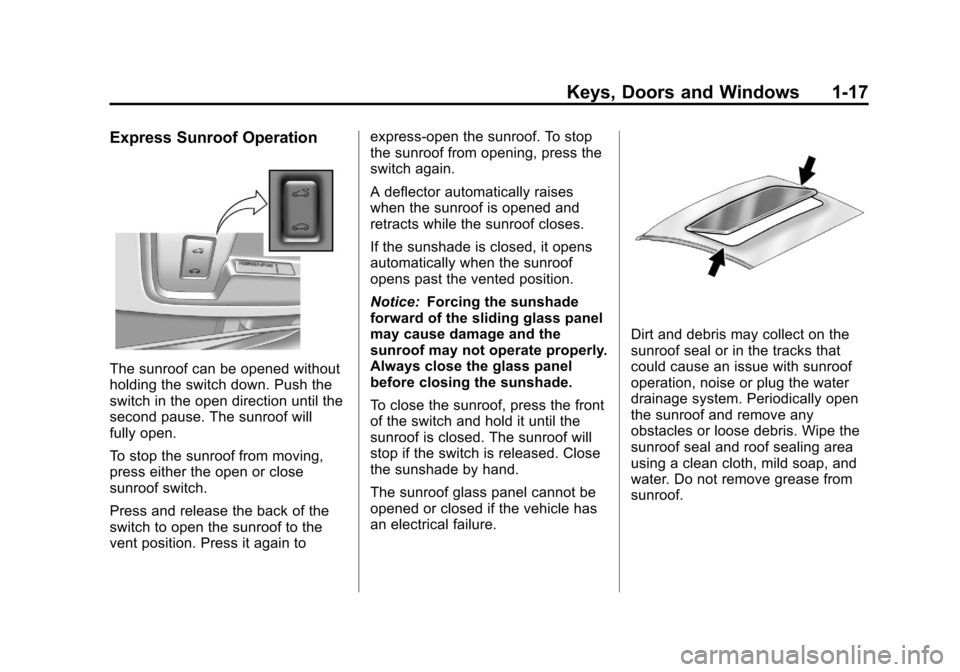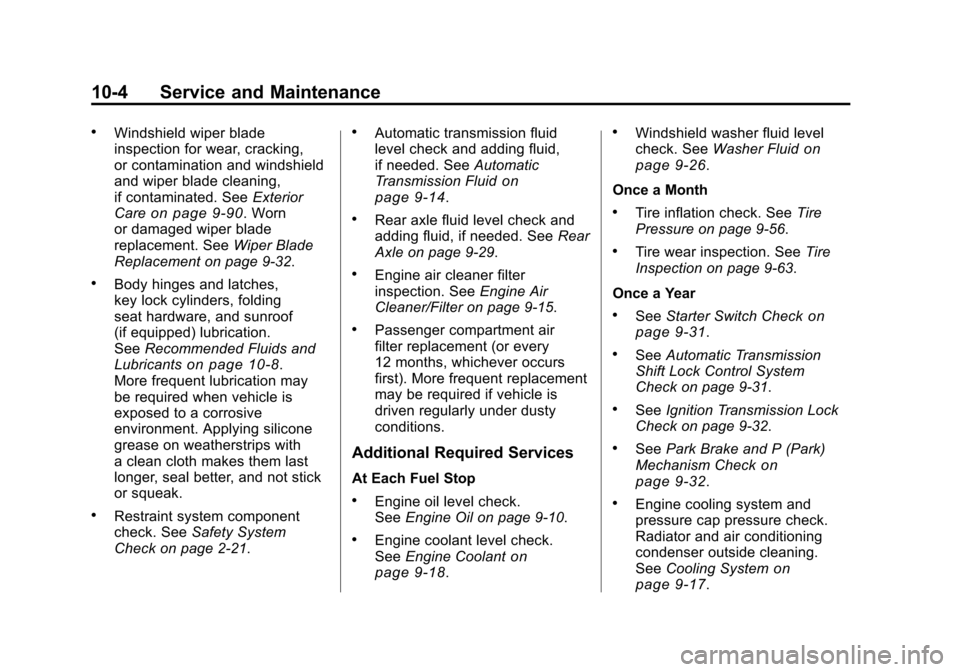roof rack CHEVROLET CAMARO 2010 5.G Owners Manual
[x] Cancel search | Manufacturer: CHEVROLET, Model Year: 2010, Model line: CAMARO, Model: CHEVROLET CAMARO 2010 5.GPages: 378, PDF Size: 5.75 MB
Page 23 of 378

Black plate (17,1)Chevrolet Camaro Owner Manual - 2010
Keys, Doors and Windows 1-17
Express Sunroof Operation
The sunroof can be opened without
holding the switch down. Push the
switch in the open direction until the
second pause. The sunroof will
fully open.
To stop the sunroof from moving,
press either the open or close
sunroof switch.
Press and release the back of the
switch to open the sunroof to the
vent position. Press it again toexpress-open the sunroof. To stop
the sunroof from opening, press the
switch again.
A deflector automatically raises
when the sunroof is opened and
retracts while the sunroof closes.
If the sunshade is closed, it opens
automatically when the sunroof
opens past the vented position.
Notice:
Forcing the sunshade
forward of the sliding glass panel
may cause damage and the
sunroof may not operate properly.
Always close the glass panel
before closing the sunshade.
To close the sunroof, press the front
of the switch and hold it until the
sunroof is closed. The sunroof will
stop if the switch is released. Close
the sunshade by hand.
The sunroof glass panel cannot be
opened or closed if the vehicle has
an electrical failure.
Dirt and debris may collect on the
sunroof seal or in the tracks that
could cause an issue with sunroof
operation, noise or plug the water
drainage system. Periodically open
the sunroof and remove any
obstacles or loose debris. Wipe the
sunroof seal and roof sealing area
using a clean cloth, mild soap, and
water. Do not remove grease from
sunroof.
Page 334 of 378

Black plate (4,1)Chevrolet Camaro Owner Manual - 2010
10-4 Service and Maintenance
.Windshield wiper blade
inspection for wear, cracking,
or contamination and windshield
and wiper blade cleaning,
if contaminated. SeeExterior
Care
on page 9‑90. Worn
or damaged wiper blade
replacement. See Wiper Blade
Replacement on page 9‑32.
.Body hinges and latches,
key lock cylinders, folding
seat hardware, and sunroof
(if equipped) lubrication.
See Recommended Fluids and
Lubricants
on page 10‑8.
More frequent lubrication may
be required when vehicle is
exposed to a corrosive
environment. Applying silicone
grease on weatherstrips with
a clean cloth makes them last
longer, seal better, and not stick
or squeak.
.Restraint system component
check. See Safety System
Check on page 2‑21.
.Automatic transmission fluid
level check and adding fluid,
if needed. See Automatic
Transmission Fluid
on
page 9‑14.
.Rear axle fluid level check and
adding fluid, if needed. See Rear
Axle on page 9‑29.
.Engine air cleaner filter
inspection. See Engine Air
Cleaner/Filter on page 9‑15.
.Passenger compartment air
filter replacement (or every
12 months, whichever occurs
first). More frequent replacement
may be required if vehicle is
driven regularly under dusty
conditions.
Additional Required Services
At Each Fuel Stop
.Engine oil level check.
See Engine Oil on page 9‑10.
.Engine coolant level check.
SeeEngine Coolanton
page 9‑18.
.Windshield washer fluid level
check. See Washer Fluidon
page 9‑26.
Once a Month
.Tire inflation check. See Tire
Pressure on page 9‑56.
.Tire wear inspection. See Tire
Inspection on page 9‑63.
Once a Year
.See Starter Switch Checkon
page 9‑31.
.See Automatic Transmission
Shift Lock Control System
Check on page 9‑31.
.See Ignition Transmission Lock
Check on page 9‑32.
.See Park Brake and P (Park)
Mechanism Checkon
page 9‑32.
.Engine cooling system and
pressure cap pressure check.
Radiator and air conditioning
condenser outside cleaning.
See Cooling System
on
page 9‑17.